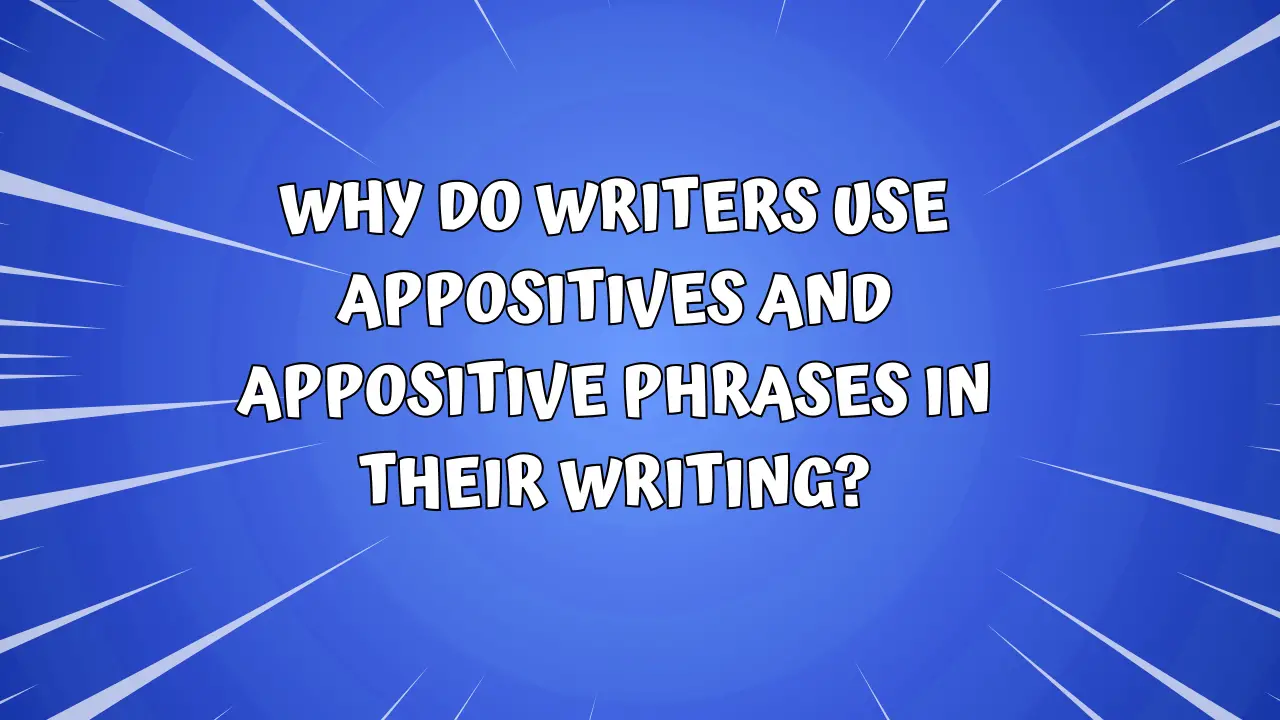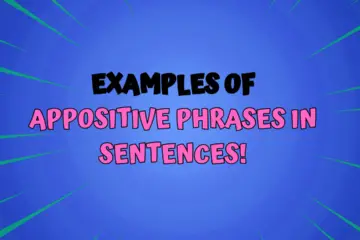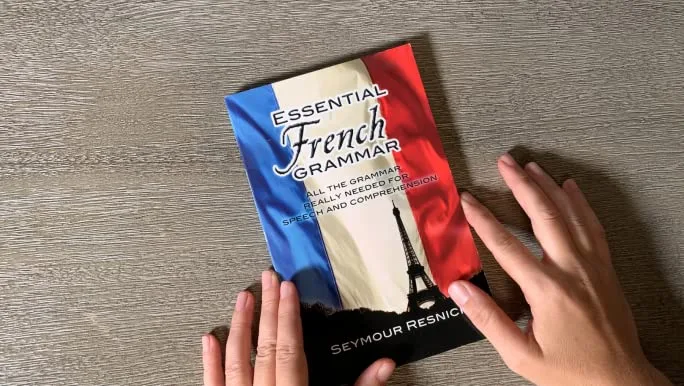Writers use appositives and appositive phrases in their writing for several reasons, as these linguistic tools offer various benefits that contribute to the overall effectiveness of communication. Here are some key reasons why writers incorporate appositives into their writing:
1. Enhanced Clarity and Precision:
In the realm of effective communication, clarity and precision are paramount, and this is precisely where appositives emerge as invaluable assets for writers. Appositives function as linguistic magnifying glasses, honing in on a specific noun within a sentence and providing a clarifying lens through which readers can discern finer details.
Consider a sentence without an appositive: “She visited her friend.” While functional, this sentence lacks specificity. Now, introduce an appositive: “She visited Maria, an old friend from college.” Suddenly, the reader is armed with additional information, gaining insight into the nature of the friendship and establishing a more detailed mental image of the scenario.
Appositives act as linguistic microscopes, zooming in on nouns and revealing layers of information that might otherwise remain dormant. They bring precision to writing by offering concise details that amplify understanding. Whether it’s identifying a specific person, clarifying a unique characteristic, or pinpointing a particular aspect of the subject, appositives contribute to a heightened level of clarity, ensuring that readers navigate the narrative terrain with utmost comprehension.
Furthermore, in technical or academic writing, where precision is non-negotiable, appositives serve as tools for meticulous articulation. For instance, “The researcher conducted experiments” becomes more precise with an appositive: “The researcher, an expert in quantum physics, conducted groundbreaking experiments.” Here, the appositive not only adds clarity to the researcher’s identity but also underscores their specialization, elevating the overall precision of the statement.
In essence, the inclusion of appositives is a deliberate choice by writers seeking to impart a granular and lucid understanding to their readers. By weaving these linguistic gems into their prose, writers enrich their narratives, providing readers with a heightened sense of clarity and an enhanced ability to envisage the intricacies of the subject matter.
2. Improved Sentence Structure:
In the intricate tapestry of writing, sentence structure serves as the loom that weaves together the fabric of communication. Appositives emerge as skilled artisans within this creative process, contributing to the artistry of well-crafted sentences and elevating the overall structure of written expression.
At its core, improved sentence structure, facilitated by appositives, goes beyond the mere arrangement of words; it involves the orchestration of a rhythmic and harmonious flow that engages the reader. Appositives act as linguistic connectors, seamlessly linking ideas within a sentence. They serve as bridges, guiding the reader from one piece of information to the next with finesse.
Consider a sentence without an appositive: “The novel was captivating.” Now, introduce an appositive: “The novel, a masterpiece of storytelling, was captivating.” The appositive not only embellishes the description but also adds a layer of complexity to the sentence structure. It transforms a straightforward statement into a more dynamic expression, creating a cadence that resonates with the reader.
Writers strategically deploy appositives at various points in a sentence to introduce variety and prevent monotony. This intentional variation in sentence structure captures the reader’s attention, making the writing more engaging and compelling. For instance, placing an appositive at the beginning of a sentence can set the tone or provide context, while incorporating it in the middle or at the end offers a different stylistic effect.
Furthermore, appositives contribute to the overall aesthetics of writing. They introduce a sense of artistry, allowing writers to sculpt their prose into a more visually and auditorily pleasing form. By breaking away from predictability, appositives infuse creativity into sentence construction, transforming the act of reading into a literary journey marked by twists and turns.
In summary, the use of appositives in writing is a deliberate choice made by authors who recognize that sentence structure is not merely a functional aspect but a canvas upon which the writer paints their narrative. Appositives, as adept brushstrokes, enhance the structure, rhythm, and beauty of sentences, ensuring that the reader experiences not just information, but a symphony of language and expression.
3. Descriptive Richness:
In the realm of language, where words strive to evoke emotions and paint vivid mental images, writers harness the power of appositives to infuse their prose with descriptive richness. Appositives act as the palette from which writers draw, allowing them to splash their narratives with vibrant hues and intricate details, creating a literary masterpiece that captivates the senses.
At its essence, descriptive richness through appositives transforms writing from a conveyance of information into a sensory experience. Consider a sentence bereft of an appositive: “The garden was beautiful.” While functional, this statement lacks the immersive quality that descriptive richness imparts. Now, introduce an appositive: “The garden, a tapestry of blooming roses and fragrant herbs, was a breathtaking sight.” Suddenly, the reader is transported into a scene alive with color, scent, and visual splendor.
Appositives serve as literary artisans, enabling writers to meticulously craft a narrative that goes beyond the ordinary. They allow for the insertion of specific details, such as characteristics, qualities, or features, that paint a more nuanced picture. Whether it’s describing a character, a place, or an event, appositives contribute layers of texture to the writing, enriching it with a sensory depth that resonates with readers.
Moreover, appositives in descriptive writing act as catalysts for reader engagement. By offering intricate details, writers invite readers to immerse themselves in the narrative, fostering a connection that transcends the mere exchange of information. For instance, “The city skyline was impressive” transforms into “The city skyline, a glittering panorama of towering skyscrapers against the twilight sky, was awe-inspiring.” In this transformation, the appositive not only adds descriptive richness but also invites the reader to envision the scene with vivid clarity.
In the intricate dance of words, writers use appositives to choreograph a narrative that dances off the page, leaving an indelible imprint on the reader’s imagination. The descriptive richness achieved through appositives elevates writing to an art form, allowing readers to not just read about a scene but to step into it, experiencing the sights, sounds, and sensations that the words evoke.
4. Emphasis and Focus:
In the symphony of language, writers orchestrate their narratives with precision, and appositives emerge as the maestros directing emphasis and focus. These linguistic instruments wield a subtle yet profound influence, guiding the reader’s attention to key elements within a sentence and sculpting the overall impact of the written composition.
Emphasis, through the strategic use of appositives, is akin to a spotlight illuminating specific facets of the narrative. Consider a sentence without an appositive: “The musician played the guitar.” Now, introduce an appositive: “The musician, a virtuoso in classical music, played the guitar.” Here, the appositive directs the reader’s attention to the musician’s expertise, emphasizing a particular aspect of their identity.
Appositives allow writers to carefully curate the focal points within their sentences, influencing the reader’s perception and interpretation. By choosing where to place additional information, writers can control the flow of attention, ensuring that the reader engages with the most salient details. This deliberate emphasis is particularly crucial in narrative arcs, where key characters, events, or ideas demand heightened scrutiny.
Moreover, appositives contribute to the creation of a thematic focus within a narrative. Whether emphasizing a character’s defining trait, an object’s unique characteristic, or an event’s pivotal moment, appositives serve as beacons guiding the reader through the thematic landscape. Through such emphasis, writers ensure that their intended message resonates clearly and echoes meaningfully in the reader’s mind.
In persuasive writing, appositives become persuasive tools, steering the reader’s focus towards compelling details that reinforce an argument or viewpoint. For instance, “The scientist conducted experiments” transforms into “The scientist, a pioneering researcher in environmental science, conducted groundbreaking experiments.” Here, the appositive reinforces the scientist’s credibility and the significance of their work, guiding the reader to the heart of the narrative.
In summary, emphasis and focus, facilitated by appositives, allow writers to sculpt their prose with intentionality. Appositives act as navigational beacons, directing the reader’s gaze towards elements of significance, thereby shaping the overall impact of the narrative and imbuing it with a sense of purpose and clarity.



